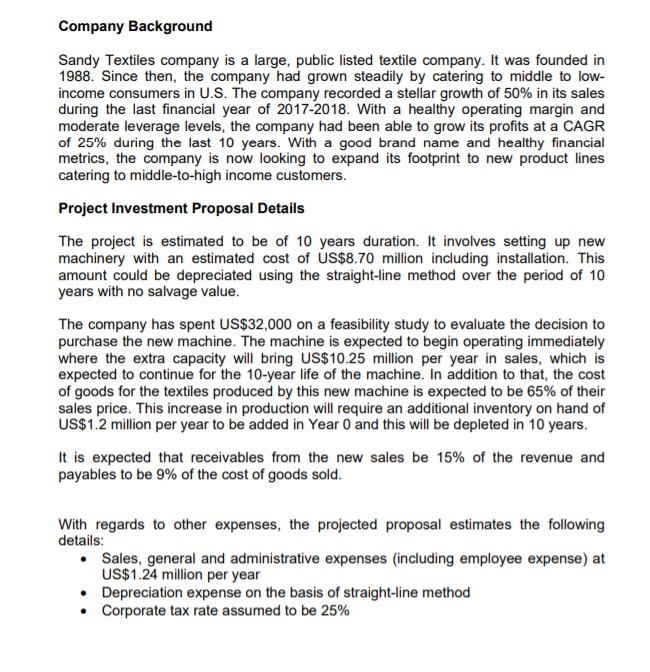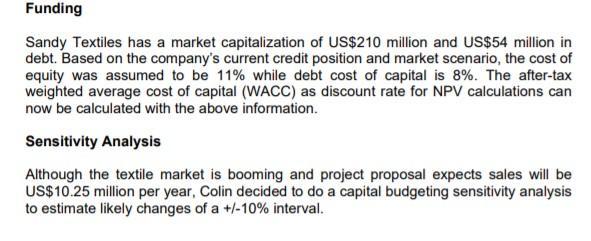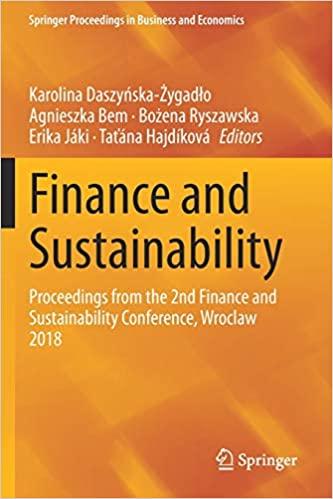Answered step by step
Verified Expert Solution
Question
1 Approved Answer
Anybody know how to calculate WACC, NPV, and IRR based on this questions please?urgently need ur help so much Introduction On July 4th, 2019, Mr.



Anybody know how to calculate WACC, NPV, and IRR based on this questions please?urgently need ur help so much
Introduction On July 4th, 2019, Mr. Colin Capers, Senior Vice President of Sandy Textile company was preparing for a meeting with the management committee schedule the next week. On his desk was a capital budgeting and investment proposal - a new product line of luxurious clothing line that the committee was considering for launch. As the head of the finance department, Colin was required to work along with his team on a detailed capital budgeting analysis and present the findings to the management committee for their approval. As per standard company practice, each capital budgeting and investment project was evaluated using the traditional Net Present Value (NPV) approach and the Internal Rate of Return (IRR) criterion for determining whether the company undertake the project or not. Colin had a lot to think about as he considered the analysis of the budgeting using the traditional Net Present Value (NPV) approach and the Internal rate of return (IRR) criterion. What would be the basis for calculating the after-tax operating cash flows for the capital project? How would he arrive at the depreciation and working capital requirements for computing the NPV? With all these questions in mind, Colin decided to focus on the proposed capital budgeting project for the next few days. U.S retail market The U.S textile retail market is currently driven by strong Gross Domestic Product (GDP) growth, mild inflation, and rising per capita income and purchasing power of consumers. Currently, the retail industry accounts for more than ten percent of the country's GDP and approximately eight percent employment. The industry is expected to nearly double, from US$600 million in 2015 to US$ 1 trillion by 2019 driven by income growth, urbanization and attitudinal shifts. It is estimated that that by 2030, the textile retail market, in particular, is expected to grow at compounded annual growth rate (CAGR) of approximately 10-12%, backed by increasing affordability on account of an increase in disposable incomes, increase in aspirations, and a shift from unbranded to branded goods by burgeoning middle class. This trend is likely to further accentuated by the rise of e-commerce companies that enable shopping anywhere, thereby leading to increased penetration in small cities and towns. Company Background Sandy Textiles company is a large, public listed textile company. It was founded in 1988. Since then, the company had grown steadily by catering to middle to low- income consumers in U.S. The company recorded a stellar growth of 50% in its sales during the last financial year of 2017-2018. With a healthy operating margin and moderate leverage levels, the company had been able to grow its profits at a CAGR of 25% during the last 10 years. With a good brand name and healthy financial metrics, the company is now looking to expand its footprint to new product lines catering to middle-to-high income customers. Project Investment Proposal Details The project is estimated to be of 10 years duration. It involves setting up new machinery with an estimated cost of US$8.70 million including installation. This amount could be depreciated using the straight-line method over the period of 10 years with no salvage value. The company has spent US$32,000 on a feasibility study to evaluate the decision to purchase the new machine. The machine is expected to begin operating immediately where the extra capacity will bring US$10.25 million per year in sales, which is expected to continue for the 10-year life of the machine. In addition to that, the cost of goods for the textiles produced by this new machine is expected to be 65% of their sales price. This increase in production will require an additional inventory on hand of US$1.2 million per year to be added in Year 0 and this will be depleted in 10 years. It is expected that receivables from the new sales be 15% of the revenue and payables to be 9% of the cost of goods sold. With regards to other expenses, the projected proposal estimates the following details: Sales, general and administrative expenses (including employee expense) at US$1.24 million per year Depreciation expense on the basis of straight-line method Corporate tax rate assumed to be 25% Funding Sandy Textiles has a market capitalization of US$210 million and US$54 million in debt. Based on the company's current credit position and market scenario, the cost of equity was assumed to be 11% while debt cost of capital is 8%. The after-tax weighted average cost of capital (WACC) as discount rate for NPV calculations can now be calculated with the above information. Sensitivity Analysis Although the textile market is booming and project proposal expects sales will be US$10.25 million per year, Colin decided to do a capital budgeting sensitivity analysis to estimate likely changes of a +/-10% intervalStep by Step Solution
There are 3 Steps involved in it
Step: 1

Get Instant Access to Expert-Tailored Solutions
See step-by-step solutions with expert insights and AI powered tools for academic success
Step: 2

Step: 3

Ace Your Homework with AI
Get the answers you need in no time with our AI-driven, step-by-step assistance
Get Started


